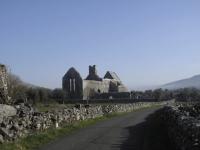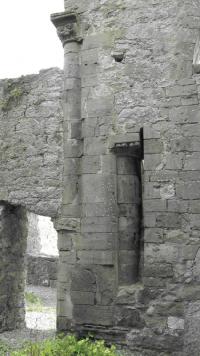Monastic Ireland website launched
Published in Issue 6 (Nov/Dec 2012), Medieval History (pre-1500), News, Volume 20
Corcomroe Abbey in the Burren, Co. Clare, and (below) detail of capitals from Monasternenagh Cistercian abbey, Co. Limerick—examples of the medieval buildings that dominate many parts of the Irish landscape. The ‘Explore’ section of the Monastic Ireland website will provide comprehensive directions to any given site, along with a gallery of images, architectural plans and details, and the history of the institution from its foundation to the present day. (Rachel Moss; Niamh NicGhabhann)
Medieval buildings dominate many parts of the Irish landscape. Castles are the largest surviving structures from medieval Ireland, and monastic buildings and their inhabitants dominate many chapters of Irish history. Accounts of the lives and fortunes of these people and the landscapes they inhabited are found across a wide range of sources—annals, letters, manuscripts—but these are not widely available in an accessible format.The first phase of this project is funded by the Department of Arts, Heritage and the Gaeltacht and Fáilte Ireland, with support from the South-Western Regional Authority, and focuses on the monastic remains of the west, south-west and north-west, such as the Franciscan friary at Timoleague and the magnificent Cistercian Hore Abbey, built in the shadow of the Rock of Cashel. The Monastic Ireland website will allow users to explore and research Ireland’s medieval heritage. The ‘Explore’ section will provide potential visitors with comprehensive directions to any given site, along with a gallery of images, architectural plans and details, and the history of the institution from its foundation to the present day. This information will be presented in a user-friendly way but will reflect the most up-to-date research (references will also be provided). Should visitors wish to explore a site in greater depth, the website will link to associated artefacts and manuscripts in libraries, museums and archives. There are also plans to develop a smartphone and tablet app, to give access to the information in a portable and site-friendly format.For scholars, the ‘Research’ section of the website brings together a comprehensive range of sources relating to each site on the database, including information from medieval annals, records relating to specific monastic orders in state and papal documents, fiants, and collections of papers from the regions in question (such as the Ormond Deeds). This will provide a comprehensive bibliography for each site. The Monastic Ireland team are also currently building a database of images of Irish architectural and sculptural history. For the Cistercian site at Monasternenagh, for example, users will be able to read the letters of Stephen of Lexington, who visited Ireland between 1228 and 1229, correcting abuses and overseeing the reform of the order there; they will also be able to view images of beautiful architectural details half-buried in later stonework and read about startling episodes in history, such as a rebellion at the monastery during which dissenting monks barricaded themselves inside the cloister. The ‘Participate’ section of the website is also in development and will include resources for schools and other visitors. It is hoped that this will become a crowd-sourcing site, where individuals and local history societies can share images and information about specific areas or buildings, and build their own collections to include on the site.
 Monastic Ireland is one of a host of innovative digital humanities projects that aim to transform our access to Ireland’s medieval heritage. The need to provide a way for members of the public to access information to a high academic standard and in an engaging and accessible manner has resulted in projects such as the Royal Irish Academy’s www.confessio.ie, which includes images of St Patrick’s Confessio in manuscript and printed form, as well as the text itself in its original Latin and a range of European languages. Similar sites include www.gothicpast.com, showcasing Irish Gothic architecture and produced as part of the IRCHSS-funded ‘Reconstructions of the Gothic Past’ project at Trinity College Dublin, and the ‘Writing Irish History’ project at www.writingirishhistory.eu, produced by Dr Edel Bhreathnach and Dr Bernadette Cunningham, which explores the Annals of the Four Masters and their medieval sources.Monastic Ireland has been developed in conjunction with the team at the University of Wales Trinity St David (Lampeter Campus) responsible for the website Monastic Wales, www.monasticwales.com, which was led by Professor Janet Burton (University of Wales Trinity St David), Dr Karen Stöber (Universitat de Lleida, Catalunya) and Dr Julie Kerr (University of St Andrews), and was designed and built by Nigel Callaghan (Technoleg Taliesin Cyf.) and Martin Crampin (University of Wales Centre for Advanced Welsh and Celtic Studies, Aberystwyth). The Monastic Ireland website will be launched in winter 2012. HI
Monastic Ireland is one of a host of innovative digital humanities projects that aim to transform our access to Ireland’s medieval heritage. The need to provide a way for members of the public to access information to a high academic standard and in an engaging and accessible manner has resulted in projects such as the Royal Irish Academy’s www.confessio.ie, which includes images of St Patrick’s Confessio in manuscript and printed form, as well as the text itself in its original Latin and a range of European languages. Similar sites include www.gothicpast.com, showcasing Irish Gothic architecture and produced as part of the IRCHSS-funded ‘Reconstructions of the Gothic Past’ project at Trinity College Dublin, and the ‘Writing Irish History’ project at www.writingirishhistory.eu, produced by Dr Edel Bhreathnach and Dr Bernadette Cunningham, which explores the Annals of the Four Masters and their medieval sources.Monastic Ireland has been developed in conjunction with the team at the University of Wales Trinity St David (Lampeter Campus) responsible for the website Monastic Wales, www.monasticwales.com, which was led by Professor Janet Burton (University of Wales Trinity St David), Dr Karen Stöber (Universitat de Lleida, Catalunya) and Dr Julie Kerr (University of St Andrews), and was designed and built by Nigel Callaghan (Technoleg Taliesin Cyf.) and Martin Crampin (University of Wales Centre for Advanced Welsh and Celtic Studies, Aberystwyth). The Monastic Ireland website will be launched in winter 2012. HI
http://www.monasticireland.org/
















